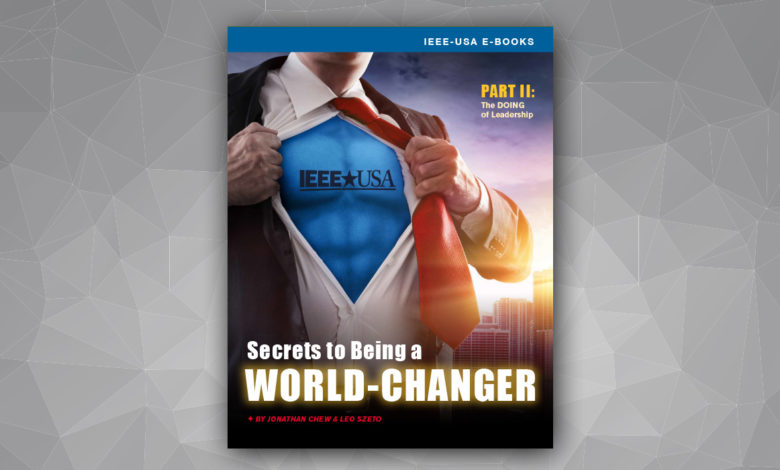
In IEEE-USA’s latest free audio book for members, Secrets to Being a World-Changer, Book 2: The DOING of Leadership, two engineers who have devoted their careers to making their dreams come true, share their passions for innovation; and their experiences at achieving success; for like-minded colleagues and fellow IEEE members who also want to dream big.
IEEE Members Jonathan Chew and Leo Szeto have written a two-part e-book—now also available as IEEE-USA’s latest audio book—that provides individuals working in any discipline with valuable insights on how to lead and implement change. Secrets to Being a World Changer, Part 2, The Doing of Leadership, describes how to implement world-changing actions. In the first volume, the co-authors discusses how to establish the mindset of a world-changing leader.
Part 2 of this audio/e-book series will provide you with examples of world-changers that can dream about an idea that has purpose; figure out how to play with that idea; gain the expertise to build it; and actually bring it to life. You will hear how they communicate that idea to others, bring them along, and enlist them as part of a larger goal. In addition, in this second part of the series, you will learn how to develop this secret set of skills.
Both men speak from on-the-job experience as Disney Imagineers, in the company’s research and development division. Disney Imagineers include illustrators, designers, architects and engineers—among the other professionals with that designation. They have been encouraged to employ “blue sky speculation,” a process where no limitations exist. Each man worked for several years on Imagineering’s design and construction of Shanghai Disneyland, which opened in 2016.
Building on the Circles of VICtory concept detailed in Part 1, The Being of Leadership, the authors believe the “doing” of leadership can be best described with three verbs, each of them fundamental to the implementation process:
- Dream: To evangelize for a better future
- Play: To assess all possibilities
- Build: To make something that matters for others“
These are the core things that leaders do to change the world, whether by spreading a message, finding an innovative solution, or putting bricks to mortar,” they say. “Regardless of the verb that’s used, the overall idea is that leaders take action.”
Chew and Szeto define a world-changer’s “dreaming” as the result of desiring a better future—a “burning desire” for a future so compelling, it stirs the imagination to devise how to make it a reality.
They point to President John F. Kennedy, and Dr. Martin Luther King, as two world leaders whose dreams led to world change.
In 1961, Kennedy inspired the nation to become an aerospace leader—challenging us to land a man on the moon by the end of that decade. “Leaders set deadlines and make concrete goals,” say Chew and Szeto. “It is a blueprint that inspires and aligns a group, daring all to contribute to great things.”
“And Dr. King had a dream so strong; he started a movement that gave a voice to an entire oppressed generation, and changed decades of political intransigence and the views of an entire nation.”
IEEE members—don’t delay, go to: https://ieeeusa.org/sdm_downloads/audiobook-secrets-to-being-a-world-changer-part-2-the-doing-of-leadership/ to download your free mp3 audio book today. You can also purchase the companion e-book for your reference for $2.99 for members only. Non-members pay $4.99.
As innovator, Walt Disney, liked to say: “The best way to get started is to quit talking and start doing!”
Georgia C. Stelluto is IEEE-USA’s Publishing Manager; Manager and Editor of IEEE-USA E-BOOKS; Department Editor for @IEEEUSA in IEEE-USA InSight; and Co-Editor of IEEE-USA Conference Brief.






